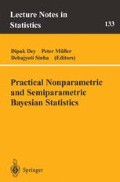Abstract
This article presents the scope of nonparametric and semi-parametric Bayesian methods for the analysis of survival data using models based on either the hazard or the intensity function. The nonparametric part of every model is assumed to have a suitable prior process. The parametric part, which may include a regression parameter or a parameter quantifying the heterogeneity of a population, is assumed to have a prior distribution with possibly unknown hyperparameters. Careful applications of some recently popular computational tools, including MCMC algorithms, are available to perform sophisticated Bayesian analyses even when we are dealing with complex models and unusual data structures.
Access this chapter
Tax calculation will be finalised at checkout
Purchases are for personal use only
Preview
Unable to display preview. Download preview PDF.
References
Andersen, P. K., Borgan, O., Gill, R. D., and Keiding, N. (1993), Statistical Models Based on Counting Processes, Springer-Verlag: New York.
Arjas, E., and Gasbarra, D. (1994), “Nonparametric Bayesian inference from right censored survival data, using the Gibbs sampler”, Statistica Sinica, 4, 505–524.
Aslanidou, H., Dey, D. K., and Sinha, D. (1998), “Bayesian analysis of multivariate survival data using Monte Carlo methods”, Canadian Journal of Statistics, 26, to appear.
Buckle, D. J. (1995), `Bayesian inference for stable distribution“. Journal of the American Statistical Association, 90, 605–613.
Burridge, J. (1981), “Empirical Bayes analysis of survival time data”. Journal of the Royal Statistical Society, Series B, 43, 65–75.
Clayton, D. (1991), “A Monte Carlo Method for Bayesian inference in frailty models”. Biometrics, 47, 467–485.
Cox, D. R. (1972), “Regression models and life tables”, Journal of the Royal Statistical Society,Series B, 34, 187–220.
Cox, D. R., and Oakes, D. (1984), Analysis of Survival Data. London: Chapman & Hall.
Duane, S., Kennedy, A. D., Pendleton, B. J., and Roweth, D. (1987) “Hybrid Monte Carlo”, Physics Letters, Series B, 195, 216–222.
Dykstra, R. L., and Laud, P. (1981), “A Bayesian nonparametric approach to reliability”. Annals of Statististics, 9, 356–367.
Ferguson, T. S. (1973), “A Bayesian analysis of some nonparametric problems”. Annals of Statistics, 1, 209–230.
Finkelstein, D. M., and Wolfe, R. A. (1985), “A semiparametric model for regression analysis of interval-censored failure time data”. Biometrics, 41, 933–945.
Gail, M. H., Santner, T. J., and Brown, C. C. (1980), “An analysis of comparative carcinogenesis experiments with multiple times to tumor”. Biometrics, 36, 255–266.
Garnerrnan, D. (1991), “Dynamic Bayesia.n models for survival data”, Applied Statistics, 40, 63–79.
Gelfand, A. E., and Mallick, B. (1995), “Bayesian analysis of proportional hazards model built from monotone functions”. Biometrics, 51, 843–852.
Ghosh, S., and Sinha, D. (1995), “Analysis of interval-censored survival data using posterior likelihood”. Technical Report, Department of Statistics, University of Connecticut, USA.
Gilks, W.R.., and Wild, P. (1992), “Adaptive Rejection Sampling for Gibbs Sampling,” Applied Statistics, 41, 337–348.
Gray, R. J. (1994), “A Bayesian analysis of institutional effects in multicenter cancer clinical trial”, Biometrics, 50, 244–253.
Gustafson, P. (1995), “Hierarchical Bayesian analysis of clustered survival data”, Technical Report # 1 44, Department of Statistics, University of British Columbia, Canada.
Hjort, N. L. (1990), “Nonparametric Bayes estimators based on beta processes in models for life history data”. Annals of Statistics, 18, 1259–1294.
Hougaard, P. (1986), “A class of multivariate failure time distribution”, Biometrika,73, 671–678.
Ibrahim, J., Chen, M-H. and MacEachern, S. N. (1996), “Bayesian variable selection for proportional hazards model”, Submitted for publication.
Kalbfleisch, J. D. (1978), “Nonparametric Bayesian analysis of survival time data”, Journal of the Royal Statistical Society, Series B, 40, 214–221.
Leonard, T. (1978), “Density estimation, stochastic processes and prior information”, Journal of the Royal Statistical Society, Series B, 40, 113–146.
Neal, R. M. (1992), “Bayesian training of backpoint propagation using hybrid Monte Carlo methods”, Technical Report, CRG-TR-92–1, Department of Computer Science, University of Toronto, Canada.
Oakes, D. (1989), “Bivariate survival models induced by frailties”. Journal of the American Statistical Association, 84, 487–493.
Oakes, D. (1992), “Frailty models for multiple event times”, Survival Analysis: State of the Art (eds. J.P. Klein and P.K. Goel), 371–379, Kluwer Academic Publisher: Netherlands.
Oakes, D. (1994), “Use of frailty models for multivariate survival data”.Proceeding of X VIIth International Biometric Conference,Hamilton,Ontario, Canada.
Qiou, Z., Ravishanker, N., and Dey, D. K. (1997), “Multivariate survival analysis with positive stable frailties”, Technical Report, Department of Statistics, University of Connecticut, USA.
Sahu, S. K., Dey, D. K., Aslanidou, H., and Sinha, D. (1997), “A Weibull Regression model with Gamma frailties for multivariate survival data”. Lifetime Data Analysis, 3, 123–137.
Sinha, D. (1993 a), “Semiparametric Bayesian analysis of multiple time data”. Journal of the American Statistical Association, 88, 979–983.
Sinha, D. (1993 b), “Semiparametric Bayesian analysis of event time data”. PhD. Thesis, University of Rochester, Rochester, NY, USA.
Sinha, D., Chen, M-H., and Ghosh, S. K. (1996), “Bayesian analysis and model selection for interval-censored survival data”. Submitted for publication.
Sinha, D. (1997), “Time-discrete beta process model for interval censored survival data”. Canadian Journal of Statistics, 25, 445–456.
Sinha, D. (1998), “Posterior likelihood method for multivariate survival data”. Biometrics, to appear.
Tanner, M. A. (1993), “Tools for Statistical Inference: Observed Data and Data Augmentation Methods”. Lecture Notes in Statistics, Springer-Verlag, New York.
Walker, S. G., and Mallick, B. K. (1996), “Hierarchical Generalized Linear models and Frailty Models with Bayesian Nonparametric Mixing”.Journal of the Royal Statistical Society, Series B,59, 845–860.
Editor information
Editors and Affiliations
Rights and permissions
Copyright information
© 1998 Springer Science+Business Media New York
About this chapter
Cite this chapter
Sinha, D., Dey, D.K. (1998). Survival Analysis Using Semiparametric Bayesian Methods. In: Dey, D., Müller, P., Sinha, D. (eds) Practical Nonparametric and Semiparametric Bayesian Statistics. Lecture Notes in Statistics, vol 133. Springer, New York, NY. https://doi.org/10.1007/978-1-4612-1732-9_10
Download citation
DOI: https://doi.org/10.1007/978-1-4612-1732-9_10
Publisher Name: Springer, New York, NY
Print ISBN: 978-0-387-98517-6
Online ISBN: 978-1-4612-1732-9
eBook Packages: Springer Book Archive

